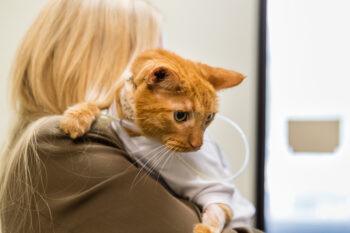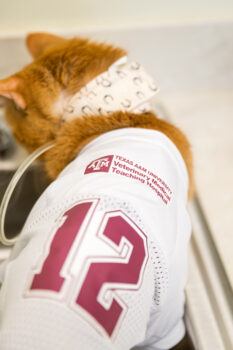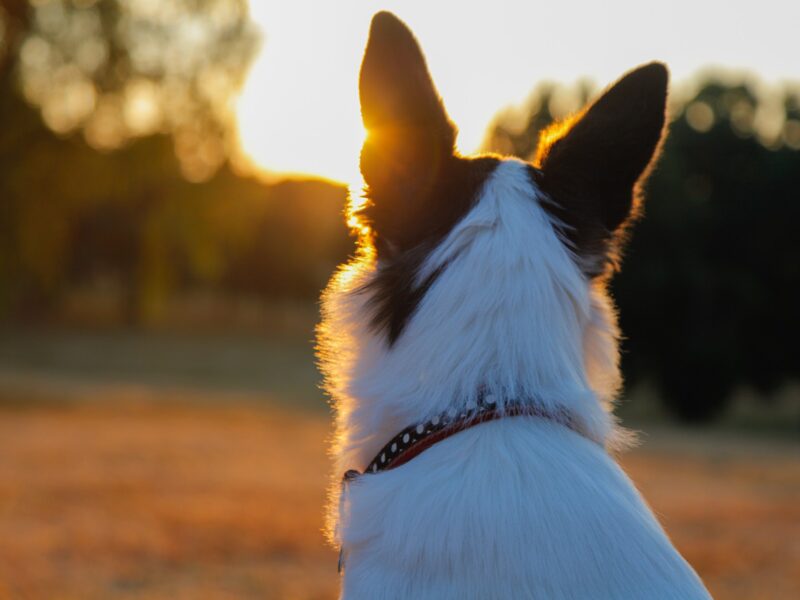Veterinarians Use Little Devices To Make Giant Impact On Cat’s Life

“James Dean,” a dapper orange tabby cat, lives a star-studded life. He fills his days playing mischievously with his sister, “Audrey Hepburn,” and his brother, “Elvis,” while his nights are spent snuggled up with his owners, Kaci and Melvin Thomas, who live in Austin.
After a sudden onset of a chronic illness created a life-or-death situation for the tabby, the Texas A&M Small Animal Teaching Hospital’s (SATH) cutting-edge Interventional Radiology Service was able to step in and save the cat’s life with a surgery not commonly offered at other veterinary hospitals.
Rebel With Four Paws

Like many SATH patients, James came to Texas A&M in great need not only of advanced veterinary care but also of hope.
He had battled urinary tract-related health challenges and was diagnosed with chronic kidney disease in the spring of 2022. Kaci worked with a veterinarian in Austin to manage his disease with a specialized diet, and for a while, the new diet was successful.
But after a year, the Thomsases noticed James’ appetite was disappearing and he was quickly losing weight. So, they took him back to the vet for complete diagnostic testing from the clinic’s lab.
“The labs came back on a Saturday, and James’ veterinarian called me immediately,” Kaci recalled. “She said that his kidney function looked really bad and that we should take him to the local veterinary hospital. The hospital kept him comfortable and stable over the weekend. Then, on Monday, the specialist and surgeons evaluated him with an ultrasound.”
James’ ultrasound revealed stones that were causing severe blockages in both kidneys.
“The specialist and surgeon mentioned a few options in terms of care, but they kept coming back to, ‘His kidneys are so bad. We think that euthanasia would be appropriate,’” Kaci shared. “I didn’t like those options, so I called his veterinarian in Austin. She referred us to Texas A&M. We picked him up from the hospital and drove to Bryan-College Station the next day.”
East Of Austin
At the SATH, James was placed under the care of Dr. Genna Atiee, a clinical assistant professor in the Department of Small Animal Clinical Sciences and specialist in the SATH’s Interventional Radiology Service.
Atiee explained that kidney disease limits the kidneys’ ability to filter blood, causing excess fluid and waste from the body to build up and create additional health problems overtime.
“Once you lose kidney cells, recovery is less likely, because the kidney doesn’t have very much regenerative capacity,” Atiee explained. “We don’t have a way to reliably remove or dissolve kidney stones in cats without some type of major intervention, so when James Dean came to us pretty sick, we recommended subcutaneous bypass devices be placed in his abdomen that allow urine to go from his kidney to his bladder and bypass the obstruction.”
Atiee and her colleague Dr. Audrey Cook, another specialist in the SATH’s Interventional Radiology Service, are two of the only veterinarians in Texas trained to surgically apply the subcutaneous bypass devices.
“We get referrals for this surgery regularly from the metro areas like Dallas, San Antonio and Austin because even though this surgery is highly effective, it’s not something every veterinarian or even every surgeon is trained to do right now,” Atiee said.
With Kaci’s approval, Atiee placed a device on one of James’ kidneys, and a couple of weeks later, on the other kidney.
“These devices require some maintenance in terms of flushing the tubes to ensure patency, and we’re happy to do that here or to work with a local specialist,” Atiee said. “The most important aspect of success post-surgery is for the family to work with us or their primary veterinarian to maintain the kidney disease.”
Kaci brought James back to Texas A&M for the early maintenance of his devices, but she now works with their local veterinarian to maintain his diet, fluid intake, and devices.
“Dr. Atiee was amazing. She called multiple times to explain the procedure, which was especially helpful because I was a little nervous in the beginning,” Kaci said. “We grew really close to James’ veterinary team at the SATH. Dr. Atiee and the students inher service were excellent to work with.”
An Award-Worthy Veterinary Performance
Today, James is doing exceptionally well; he’s back to a healthy weight and playing with Audrey and Elvis again.
“Here we are many months later and he’s still kicking, doing very well, and is still happy and loving,” Kaci said. “I really like that the SATH’s veterinarians provide the most advanced care possible. Everyone’s up to date on all the newest and best evidence-based care. I’d recommend them to anyone and would encourage others to work with the Texas A&M veterinarians.”
Atiee echoed Kaci’s encouragement to pet owners.
“There are things that we are doing that are not available in a lot of places and a lot of people may not be aware of these options, particularly in the urinary tract,” Atiee said. “We also do virtual consultations, so even if you live far away, we’re happy to schedule an online appointment and discuss options. We want to help these animals. We will do everything we can to get a patient in who we can help.”
Media contact: Jennifer Gauntt, jgauntt@cvm.tamu.edu





